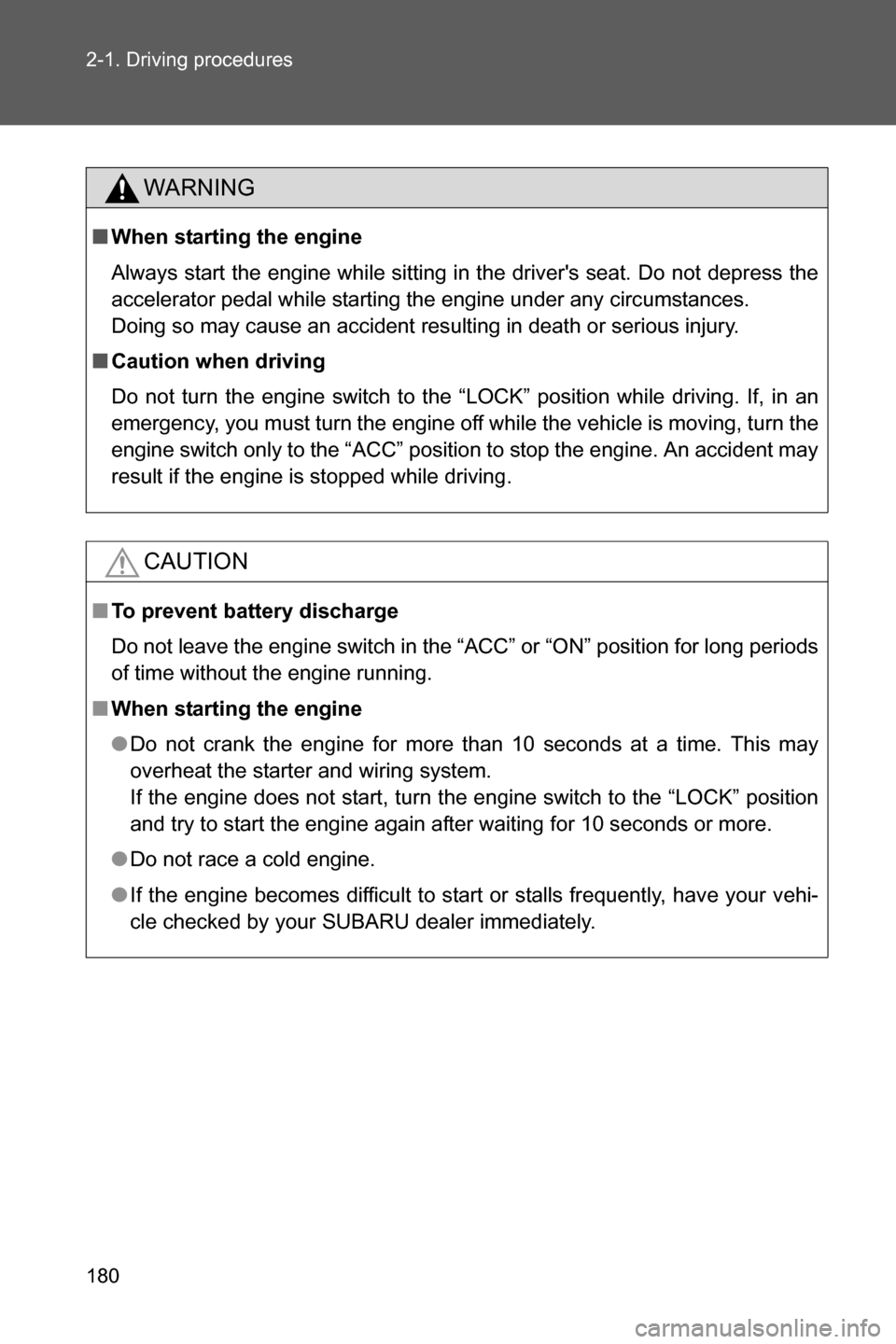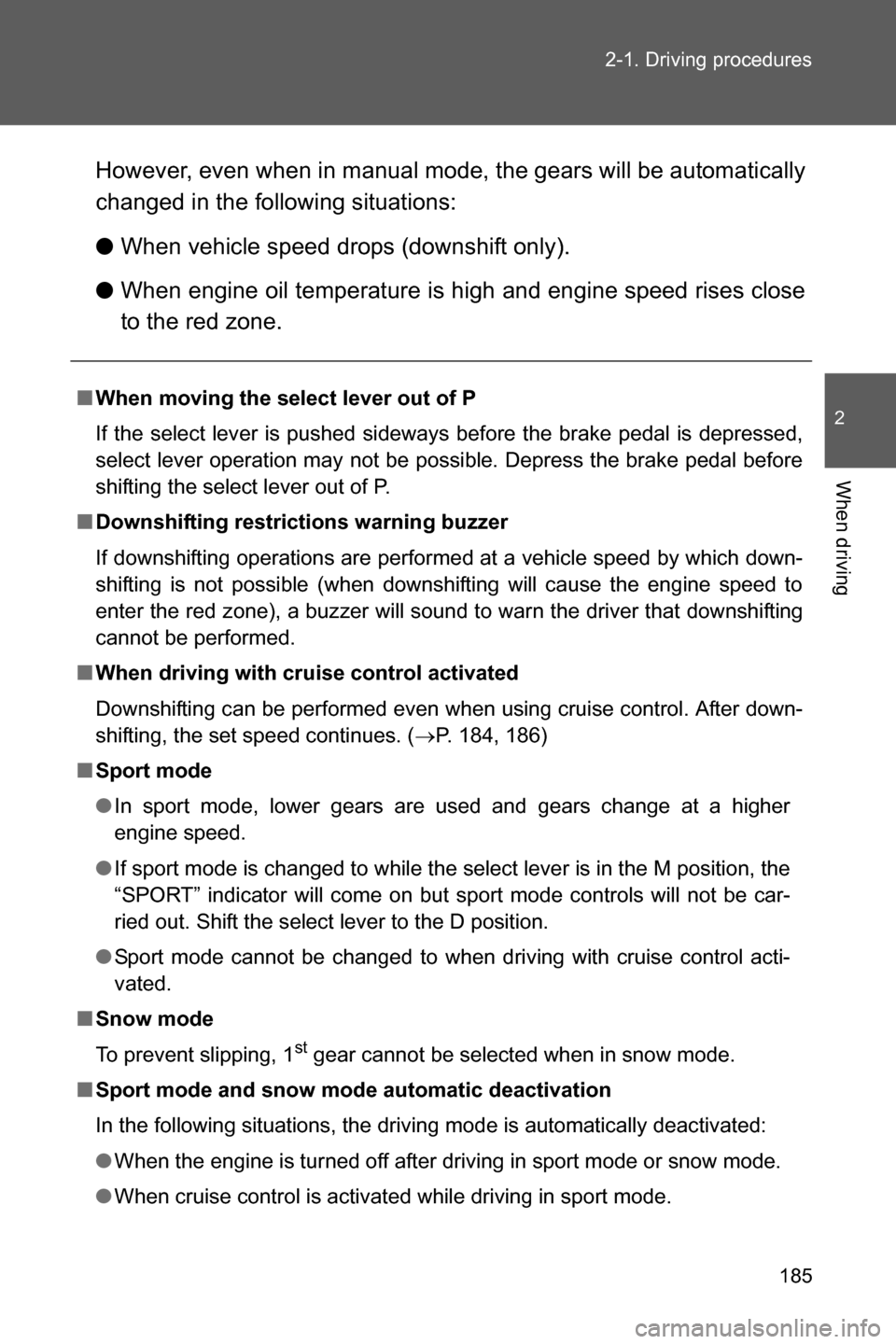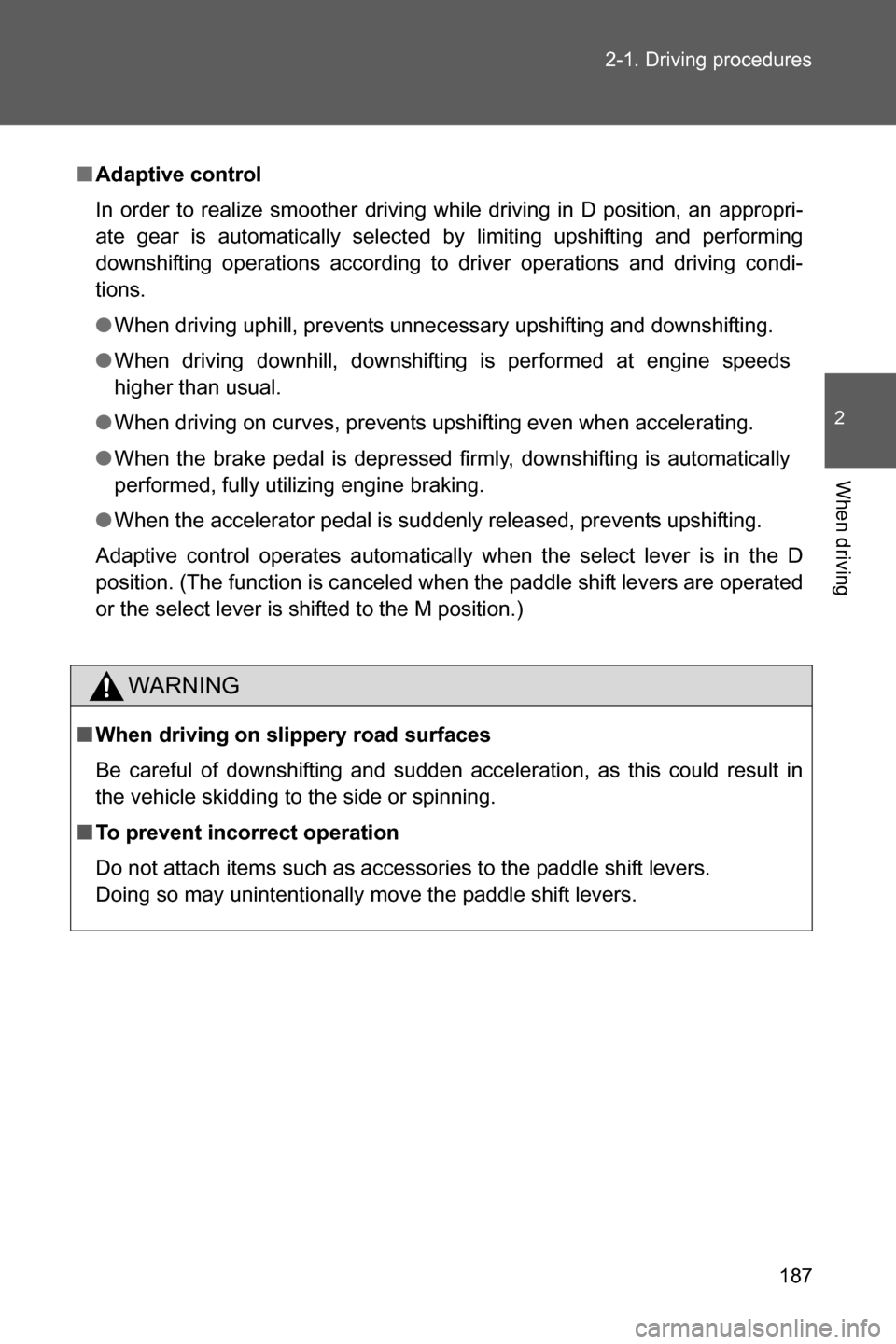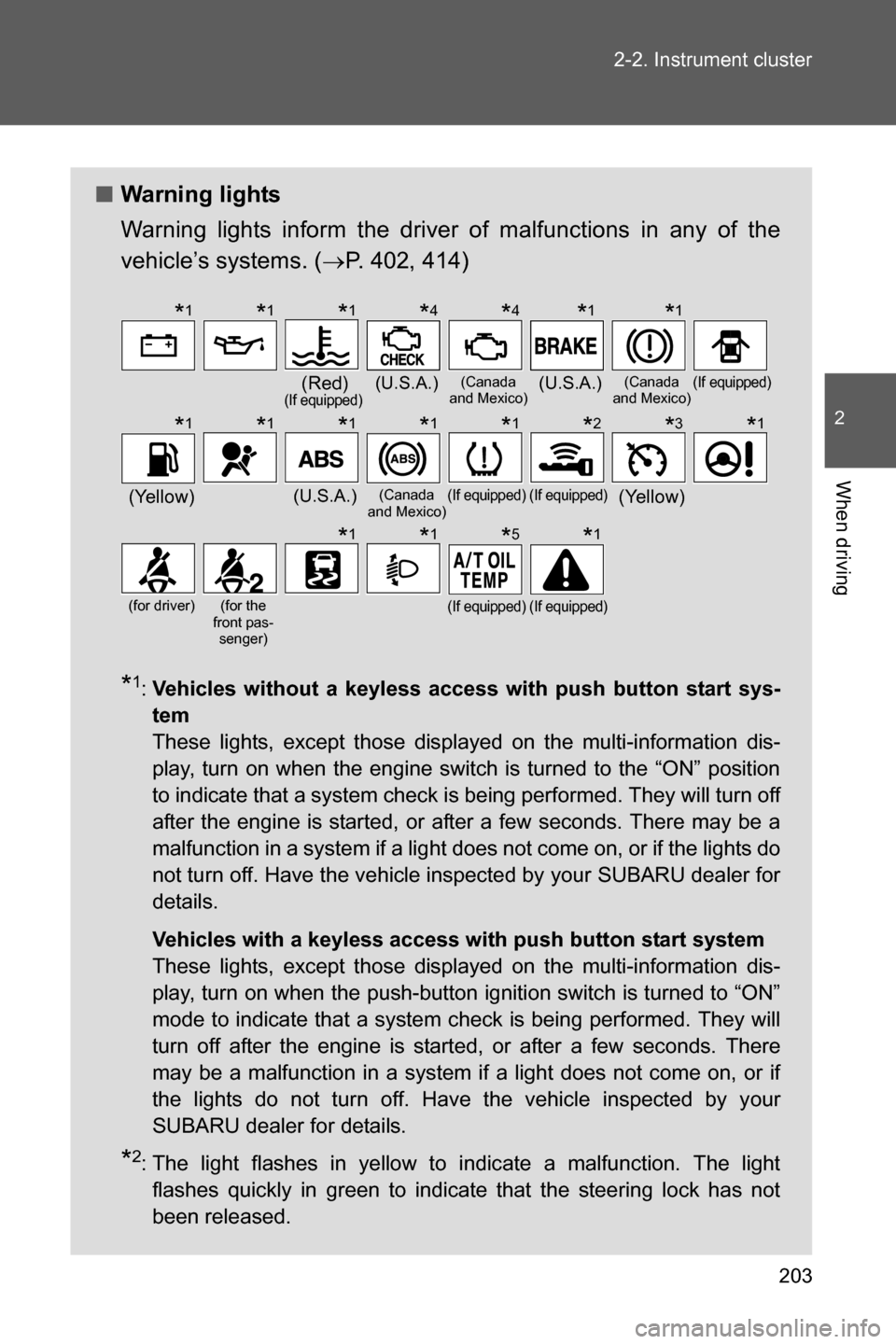Page 174 of 540
172 2-1. Driving procedures
■Changing push-button ignition switch mode
Modes can be changed by pressing the push-button ignition switch
with the brake pedal (vehicles with an automatic transmission) or
clutch pedal (vehicles with a manual transmission) released. (The
mode changes each time the switch is pressed.)
Off*
The hazard warning flashers
can be used.
The keyless access with push
button start system indicator
light (green) is off.
“ACC” mode
Some electrical components
such as the power outlet can
be used.
The keyless access with push
button start system indicator
light (green) flashes slowly.
“ON” mode
All electrical components can
be used.
The keyless access with push
button start system indicator
light (green) flashes slowly.
*: Vehicles with an automatic
transmission: If the select lever
is in a position other than P
when turning off the engine, the
push-button ignition switch will
be turned to “ACC” mode, not
to off.
Page 178 of 540

176 2-1. Driving procedures
■Immediately after reconnecting the battery terminals due to replacing
the battery and so forth
The engine may not start. If this occurs, turn the push-button ignition switch
to “ON” mode, and start the engine after waiting at least 10 seconds. Idling
may be unstable immediately after the engine starts, however, this is not a
malfunction.
WARNING
■When starting the engine
●Always start the engine while sitting in the driver’s seat. Do not depress
the accelerator pedal while starting the engine under any circumstances.
Doing so may cause an accident resulting in death or serious injury.
●If the keyless access with push button start system indicator light flashes
in green after the engine has started, never drive the vehicle. The steering
wheel is still locked, and it may result in an accident.
■Caution while driving
If engine failure occurs while the vehicle is moving, do not lock or open the
doors until the vehicle reaches a safe and complete stop. Activation of the
steering lock in this circumstance may lead to an accident, resulting in death
or serious injury.
■Stopping the engine
Do not touch the push-button ignition switch during driving.
When the push-button ignition switch is pressed for 2 seconds or longer or
pressed 3 times successively, the engine will stop. When the engine stops,
the brake booster will not function. A greater foot pressure will be required
on the brake pedal.
The power steering system will not operate either. A greater force will be
required to steer, and it may result in an accident.
Page 182 of 540

180 2-1. Driving procedures
WARNING
■When starting the engine
Always start the engine while sitting in the driver's seat. Do not depress the
accelerator pedal while starting the engine under any circumstances.
Doing so may cause an accident resulting in death or serious injury.
■Caution when driving
Do not turn the engine switch to the “LOCK” position while driving. If, in an
emergency, you must turn the engine off while the vehicle is moving, turn the
engine switch only to the “ACC” position to stop the engine. An accident may
result if the engine is stopped while driving.
CAUTION
■To prevent battery discharge
Do not leave the engine switch in the “ACC” or “ON” position for long periods
of time without the engine running.
■When starting the engine
●Do not crank the engine for more than 10 seconds at a time. This may
overheat the starter and wiring system.
If the engine does not start, turn the engine switch to the “LOCK” position
and try to start the engine again after waiting for 10 seconds or more.
●Do not race a cold engine.
●If the engine becomes difficult to start or stalls frequently, have your vehi-
cle checked by your SUBARU dealer immediately.
Page 187 of 540

185 2-1. Driving procedures
2
When driving
However, even when in manual mode, the gears will be automatically
changed in the following situations:
●When vehicle speed drops (downshift only).
●When engine oil temperature is high and engine speed rises close
to the red zone.
■When moving the select lever out of P
If the select lever is pushed sideways before the brake pedal is depressed,
select lever operation may not be possible. Depress the brake pedal before
shifting the select lever out of P.
■Downshifting restrictions warning buzzer
If downshifting operations are performed at a vehicle speed by which down-
shifting is not possible (when downshifting will cause the engine speed to
enter the red zone), a buzzer will sound to warn the driver that downshifting
cannot be performed.
■When driving with cruise control activated
Downshifting can be performed even when using cruise control. After down-
shifting, the set speed continues. (�oP. 184, 186)
■Sport mode
●In sport mode, lower gears are used and gears change at a higher
engine speed.
●If sport mode is changed to while the select lever is in the M position, the
“SPORT” indicator will come on but sport mode controls will not be car-
ried out. Shift the select lever to the D position.
●Sport mode cannot be changed to when driving with cruise control acti-
vated.
■Snow mode
To prevent slipping, 1
st gear cannot be selected when in snow mode.
■Sport mode and snow mode automatic deactivation
In the following situations, the driving mode is automatically deactivated:
●When the engine is turned off after driving in sport mode or snow mode.
●When cruise control is activated while driving in sport mode.
Page 189 of 540

187 2-1. Driving procedures
2
When driving
■Adaptive control
In order to realize smoother driving while driving in D position, an appropri-
ate gear is automatically selected by limiting upshifting and performing
downshifting operations according to driver operations and driving condi-
tions.
●When driving uphill, prevents unnecessary upshifting and downshifting.
●When driving downhill, downshifting is performed at engine speeds
higher than usual.
●When driving on curves, prevents upshifting even when accelerating.
●When the brake pedal is depressed firmly, downshifting is automatically
performed, fully utilizing engine braking.
●When the accelerator pedal is suddenly released, prevents upshifting.
Adaptive control operates automatically when the select lever is in the D
position. (The function is canceled when the paddle shift levers are operated
or the select lever is shifted to the M position.)
WARNING
■When driving on slippery road surfaces
Be careful of downshifting and sudden acceleration, as this could result in
the vehicle skidding to the side or spinning.
■To prevent incorrect operation
Do not attach items such as accessories to the paddle shift levers.
Doing so may unintentionally move the paddle shift levers.
Page 199 of 540
197 2-2. Instrument cluster
2
When driving
CAUTION
■To prevent damage to the engine and its components
●Do not let the indicator needle of the tachometer enter the red zone, which
indicates the maximum engine speed.
●In the following situations, the engine may be overheating. In this case,
immediately stop the vehicle in a safe place, and check the engine after it
has cooled completely. (�oP. 458)
• Vehicles with a monochrome multi-information display: The engine
coolant temperature gauge enters the red zone
• Vehicles with a color multi-information display: The high engine coolant
temperature warning light flashes or illuminates
Page 200 of 540
198
2-2. Instrument cluster
Indicators and war ning lights
The indicator and warning lights on the instrument cluster and cen-
ter panel inform the driver of the status of the vehicle’s various sys-
tems.
For the purpose of explanation, the following illustration displays all
indicators and warning lights illuminated.
Instrument cluster (with monochrome display)
Instrument cluster (with color display)
Page 205 of 540

203 2-2. Instrument cluster
2
When driving
■Warning lights
Warning lights inform the driver of malfunctions in any of the
vehicle’s systems. (�oP. 402, 414)
*1:Vehicles without a keyless access with push button start sys-
tem
These lights, except those displayed on the multi-information dis-
play, turn on when the engine switch is turned to the “ON” position
to indicate that a system check is being performed. They will turn off
after the engine is started, or after a few seconds. There may be a
malfunction in a system if a light does not come on, or if the lights do
not turn off. Have the vehicle inspected by your SUBARU dealer for
details.
Vehicles with a keyless access with push button start system
These lights, except those displayed on the multi-information dis-
play, turn on when the push-button ignition switch is turned to “ON”
mode to indicate that a system check is being performed. They will
turn off after the engine is started, or after a few seconds. There
may be a malfunction in a system if a light does not come on, or if
the lights do not turn off. Have the vehicle inspected by your
SUBARU dealer for details.
*2: The light flashes in yellow to indicate a malfunction. The light
flashes quickly in green to indicate that the steering lock has not
been released.
(Red)(If equipped)(U.S.A.)(Canada
and Mexico)(U.S.A.)(Canada
and Mexico)(If equipped)
(Yellow)(U.S.A.)(Canada
and Mexico)(If equipped)(If equipped)(Yellow)
(for driver)(for the
front pas-
senger)(If equipped)(If equipped)
*1*1*1*4*4*1*1
*1*1*1*1*1*2*3*1
*1*1*5*1